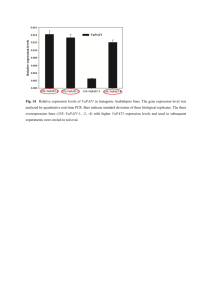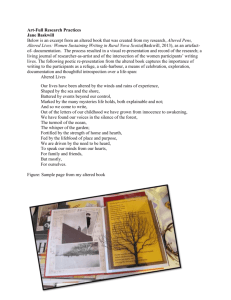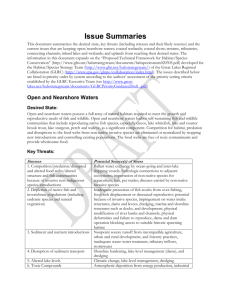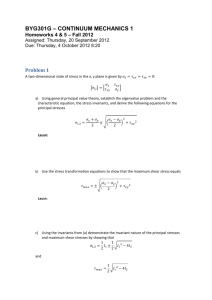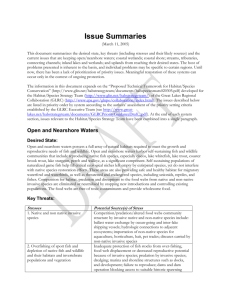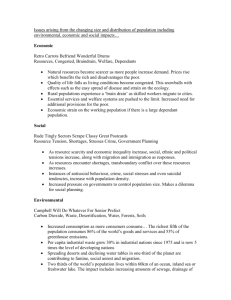Issue Summary for Great Lakes Coastal Wetlands
advertisement
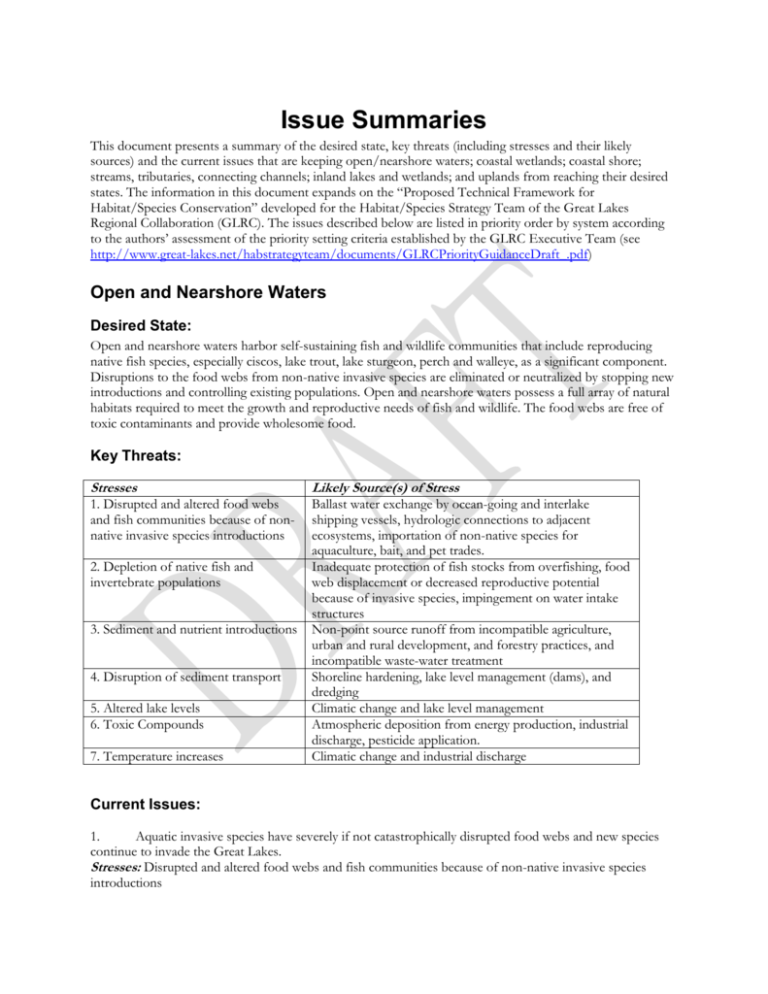
Issue Summaries This document presents a summary of the desired state, key threats (including stresses and their likely sources) and the current issues that are keeping open/nearshore waters; coastal wetlands; coastal shore; streams, tributaries, connecting channels; inland lakes and wetlands; and uplands from reaching their desired states. The information in this document expands on the “Proposed Technical Framework for Habitat/Species Conservation” developed for the Habitat/Species Strategy Team of the Great Lakes Regional Collaboration (GLRC). The issues described below are listed in priority order by system according to the authors’ assessment of the priority setting criteria established by the GLRC Executive Team (see http://www.great-lakes.net/habstrategyteam/documents/GLRCPriorityGuidanceDraft_.pdf) Open and Nearshore Waters Desired State: Open and nearshore waters harbor self-sustaining fish and wildlife communities that include reproducing native fish species, especially ciscos, lake trout, lake sturgeon, perch and walleye, as a significant component. Disruptions to the food webs from non-native invasive species are eliminated or neutralized by stopping new introductions and controlling existing populations. Open and nearshore waters possess a full array of natural habitats required to meet the growth and reproductive needs of fish and wildlife. The food webs are free of toxic contaminants and provide wholesome food. Key Threats: Stresses Likely Source(s) of Stress 1. Disrupted and altered food webs and fish communities because of nonnative invasive species introductions Ballast water exchange by ocean-going and interlake shipping vessels, hydrologic connections to adjacent ecosystems, importation of non-native species for aquaculture, bait, and pet trades. Inadequate protection of fish stocks from overfishing, food web displacement or decreased reproductive potential because of invasive species, impingement on water intake structures Non-point source runoff from incompatible agriculture, urban and rural development, and forestry practices, and incompatible waste-water treatment Shoreline hardening, lake level management (dams), and dredging Climatic change and lake level management Atmospheric deposition from energy production, industrial discharge, pesticide application. Climatic change and industrial discharge 2. Depletion of native fish and invertebrate populations 3. Sediment and nutrient introductions 4. Disruption of sediment transport 5. Altered lake levels 6. Toxic Compounds 7. Temperature increases Current Issues: 1. Aquatic invasive species have severely if not catastrophically disrupted food webs and new species continue to invade the Great Lakes. Stresses: Disrupted and altered food webs and fish communities because of non-native invasive species introductions Action: Address jointly with the Invasive Species Team 2. Restoration of sustainable native lake trout remains elusive in Lakes Michigan, Huron, Erie and Ontario Stresses: Depletion of native fish and invertebrate populations Action: Address within HS Team. 3. The abundance of Diporeia has declined substantially in Lakes Michigan and Ontario. Stresses: Disrupted and altered food webs and fish communities because of non-native invasive species introductions, depletion of native fish and invertebrate populations Action: Address jointly with the Invasive Species Team 4. Native lake herring and deep water cisco species are depleted or absent from offshore fish communities. Stresses: Disrupted and altered food webs and fish communities because of non-native invasive species introductions, depletion of native fish and invertebrate populations, altered lake levels Action: Address jointly with the Invasive Species Team 5. Yellow perch, walleye, lake whitefish, and cisco populations have been unstable because of poor recruitment and/or excessive mortality. Stresses: Disrupted and altered food webs and fish communities because of non-native invasive species introductions, depletion of native fish and invertebrate populations, altered lake levels Action: Address jointly with the Invasive Species Team 6. Filamentous algae fowls beaches Stresses: Sediment and nutrient introductions Action: Address jointly with Coastal Health Team. 7. Spawning substrates and submerged aquatic plants have been disrupted by sedimentation and dredging. Stresses: Disruption of sediment transport Action: Address jointly with Nonpoint Source Team. 8. Loss of species and biodiversity continues Stresses: Disrupted and altered food webs and fish communities because of non-native invasive species introductions, depletion of native fish and invertebrate populations, temperature increases Action: Address jointly with the Invasive Species Team 9. Periodic outbreaks of botulism in nearshore waters of some of the Great Lakes. Stresses: Disrupted and altered food webs and fish communities because of non-native invasive species introductions, toxic compounds Action: Address jointly with the Invasive Species Team Great Lakes Coastal Wetlands Desired State: Coastal wetland quantities remain, at minimum, consistent at baseline levels according to type. Wetland quality remains consistent for all major trophic levels when compared to reference sites. Targeted and coordinated restoration and protection of priority wetlands results in an overall net gain in quantity and qualitative improvement according to biological integrity metrics. Wetlands in hydrologically modified environments are improved according to biological integrity metrics. Non-native species are controlled from expanding their dominance of vegetative composition in basin wetlands. Key Threats: The table below lists the major stresses that are impacting coastal wetlands along with the likely sources of those stresses. These stresses are then linked to the major issues in the last section. Stresses Likely Source(s) of Stress 1. Alteration of natural water level fluctuations and flows 2. Competition/altered food webs/altered structure by invasive non-indigenous species 3. Direct destruction 4. Temperature increases Lake level management (dams), impervious surfaces, climate change. Ballast water, aquaculture, pet trade, bait, boating vectors, landscaping Draining/filling for development, agriculture. Climate change, industrial discharge, impervious surfaces. Shoreline hardening (jetties, seawalls, etc.), lake level management (dams), climate change Atmospheric deposition (energy production); industrial discharge. Non-point source runoff from incompatible agricultural, development and forestry practices; scouring due to impervious surfaces 5. Alteration of sediment transport 6. Addition of toxic compounds 7. Sedimentation Current Issues: 1. Wetland loss and degradation continues, but since coastal wetland quality and quantity are not currently consistently monitored across the basin, impacts to biota are difficult to calculate. Enforcement of existing regulations is insufficient. Stresses: Direct destruction from development; lack of data collection. Action: Address within HS Team. 2. Non-indigenous species continue to invade coastal wetlands and spread to dominant monocultures. Stresses: Primarily non-native species; indirectly water level and flow alterations; sedimentation; temperature alterations. Action: Address indirect stresses jointly with other teams. Address non-native spread within HS Team. 3. Water level controls and hydrological modifications in many areas have diminished biotic diversity and wetland function. Stresses: Alteration of natural water level fluctuations and flows Action: Address jointly with Sustainable Development Team. 4. Intact coastal wetlands are breeding habitat or refugia for native fish and wildlife; however, such areas are in need of restoration to maintain current functioning. Restoration initiatives suffer from a lack of coordination and monitoring. Stresses: Non-native species; water flow and level alteration; direct destruction from development. Action: Address stresses jointly with SD and AIS Teams. Address coordination and monitoring of restoration initiatives within HS Team. 5. Loss of species and biodiversity continues. Stresses: Direct destruction; non-native species; water level and flow alterations; sedimentation; temperature increases Action: Address stresses jointly with multiple teams. Address conservation and biodiversity restoration coordination within HS Team. 6. Contaminants affecting breeding efficacy of wetland-resident species. Stresses: Addition of toxic compounds. Action: Address through PBT Team. Coastal Shore Desired State: Coastal shore habitats and natural processes that sustain them, such as sediment transport, lake level fluctuation, wetland migration, are maintained and restored. These coastal habitats sustain long-term viable populations of all native species, especially endemic species (e.g., Pitchers thistle, dwarf lake iris, Houghton’s goldenrod); meet federal and state recovery plan goals for these species; and provide habitat for migratory animals (e.g., insects, birds, bats). Key Threats: Threat stresses and sources for coastal shore systems in order of impact. Stresses Likely Source(s) of Stress 1. Direct destruction Shoreline hardening, home and commercial development, sand dune and alvar mining Shoreline hardening (jetties, seawalls, etc.), lake level management (dams) Non-point source runoff from incompatible agricultural, development and forestry practices Non-intentional introductions, escaped garden plants, recreation (boating) 2. Alteration of sediment transport 3. Sedimentation 4. Competition /altered food webs/altered structure by invasive nonindigenous species Current Issues: 1. Island and coastal shorelines are under intense development pressure and land use decision making is highly local, resulting in uncoordinated decision-making that fails to provide long-term conservation of ecological priorities or maintain ecological functions that sustain habitats and species. Stresses: Direct destruction Action: Address within HS Team. 2. Laws and enforcement to prevent sand and limestone mining in ecologically-sensitive areas are ineffective. Stresses: Direct destruction Action: Address within HS Team. 3. 80% of the Great Lakes shoreline is privately owned; there are a lack of incentives and appreciation for non-structural shoreline protection. Stresses: Alteration of sediment transport Action: Address within HS Team. 4. Sedimentation from non-point source runoff is continuing to result from incompatible agriculture, development, and forestry practices. Shoreline processes are disrupted and pollution impacts species and human health. Stresses: Sedimentation, alteration of sediment transport Action: Address through Nonpoint Source and PBT Teams 5. Non-indigenous invasive species continue to disrupt coastal habitats. Stresses: Competition /altered food webs/altered structure by invasive non-indigenous species Action: Address jointly with the Invasive Species Team Riverine systems: streams, tributaries and connecting channels Desired State: Stream, rivers, and connecting channels are conserved or restored to ensure their long-term viability, defined by the presence of longitudinal connectivity; lateral connectivity to riparian floodplains and wetlands; ability to sustain native fishes, other aquatic biota, and other wildlife that depend on intact stream corridors, such as migratory birds. Land and water management practices are in place to support a natural flow regime, including protection of ground water sources, and to prevent excessive inputs of nutrients and sediment. Key Threats: Threat stresses and sources for riverine systems ranked in order of impact. Stresses Likely Source(s) of Stress 1. Physical modification of stream banks and channels. 2. Alteration or disruption of stream flow patterns and groundwater recharge Conversion of riparian zone, road building, stream channelization, and shoreline stabilization/hardening. Dams and dam operation, diversions, excessive withdrawals, agricultural drainage (tiling), incompatible storm water management, impermeable surfaces (housing and commercial development) Incompatible agricultural practices (tiling, tillage), incompatible forestry, incompatible development, road building and maintenance Dams, culverts, road/stream crossings Excessive groundwater withdrawal, impermeable surfaces (housing and commercial development), riparian vegetation removal, impoundments, industrial discharge, climate change Aquatic invasive species introduced through ballast water, aquaculture, pet trade, bait, recreation (boating); direct stocking Industrial/municipal emissions and discharge; incompatible mining practices; atmospheric deposition 3. Altered sediment regime 4. Fragmentation 5. Temperature increases 6. Competition /altered food webs/altered structure 7. Physical deformities and failure to reproduce (fish, birds, mussels) Current Issues: 1. Land use decision making is highly local, resulting in uncoordinated decision-making that fails to provide long-term conservation of ecological priorities or maintain ecological functions that sustain habitats and species. Stresses: Physical modification of stream banks and channels, alteration or disruption of stream flow patterns and groundwater recharge, altered sediment regime, fragmentation Action: Address within HS Team. 2. Focus on engineered solutions to erosion and lack of incentives and appreciation for non-structural shoreline protection. Stresses: Physical modification of stream banks and channels, alteration or disruption of stream flow patterns and groundwater recharge, altered sediment regime, Action: Address within HS Team. 3. Understanding of hydrology being a key process that maintains stream integrity is low and this is reflected the lack of laws to address water quantity, source water protection, and flow patterns. Stresses: Physical modification of stream banks and channels, alteration or disruption of stream flow patterns and groundwater recharge, fragmentation Action: Address within HS Team. 4. Impacts to riverine systems are cumulative in nature. Stresses: Competition /altered food webs/altered structure, physical deformities and failure to reproduce (fish, birds, mussels) Action: Address jointly with NP and PBT Teams 5. Non-indigenous invasive species continue to disrupt tributary habitats. Stresses: Competition /altered food webs/altered structure Action: Address jointly with IS Team 6. Non-point source runoff into streams contributes to contamination at river mouths and in the Lakes. The sediment regime has been altered due to incompatible agricultural, forest, development and road building and maintenance practices. Stresses: Physical deformities and failure to reproduce (fish, birds, mussels) Action: Address jointly with NP and PBT Teams Inland lakes and wetlands Desired State: Inland wetlands and lakes increase or are restored to sufficiently meet the needs of wildlife, water quality, groundwater recharge, flood attenuation and recreations. Native species are an integral and healthy component of the fish community. Key Threats: Stresses 1. Direct destruction 2. Altered hydrology 3. Competition, altered food webs, altered structure 4. Eutrophication (nutrient enrichment) 5. Fragmentation of wetlands Likely Source(s) of Stress Draining and filling for home and commercial development and agriculture Dams and dam operations, diversions, withdrawals, agricultural drainage, incompatible storm water management, excessive groundwater withdrawal Aquatic invasive species introduced through aquaculture, pet trade, bait, recreational boating, landscaping, direct stocking Incompatible development, incompatible wastewater treatment Dams, culverts, road and stream crossings 6. Temperature increases 7. Toxic compounds Incompatible forestry, incompatible water management, climate change Incompatible storm water and agricultural management Current Issues: 1. Inland wetlands continue to be drained and filled for home and commercial development and agriculture. Stresses: Direct destruction, altered hydrology, temperature increases Action: Address within HS Team. 2. Inland lakes continue to suffer from nutrient enrichment. 3. Aquatic invasive species are impacting inland wetland and lake species and communities. Stresses: Eutrophication (nutrient enrichment) Action: Address within HS Team. Stresses: Competition, altered food webs, altered structure Action: Address jointly with IS Team Uplands Desired State Upland habitats remain sufficiently large and connected to maintain plant and animal diversity. Upland habitats are adequately connected to provide migration corridors for species. Native plant and animal populations are thriving. Erosion to surface waters is controlled and groundwater is recharged. Key Threats Stresses Likely Source(s) of Stress 1. Fragmentation, direct destruction Incompatible development, conversion to agriculture, incompatible forestry practices. Fire management policy of suppression. Management of/for certain species (deer, maple, aspen, etc.); invasive species from management activities; accidental introduction; landscaping; pathogens; climate change. 2. Altered fire regime 3. Altered composition/altered structure Current Issues 1. The value of prairies/grasslands, savannas, barrens, forests, and other upland habitats are consistently undervalued. This results in destruction and fragmentation of natural habitats and their utility as major influencers of the rate, periodicity and quality of precipitation and groundwater recharge as well as migration corridors and habitats for many species. Stresses: Fragmentation, direct destruction. Action: Address within the HS Team. 2. Non-indigenous invasive species continue to disrupt upland habitats. Stresses: Altered composition/altered structure Action: Address jointly with IS Team 3. Habitats and species continue to be lost due to poor management practices such as the suppression of fire. Stresses: Altered fire regime Action: Address within the HS Team.


